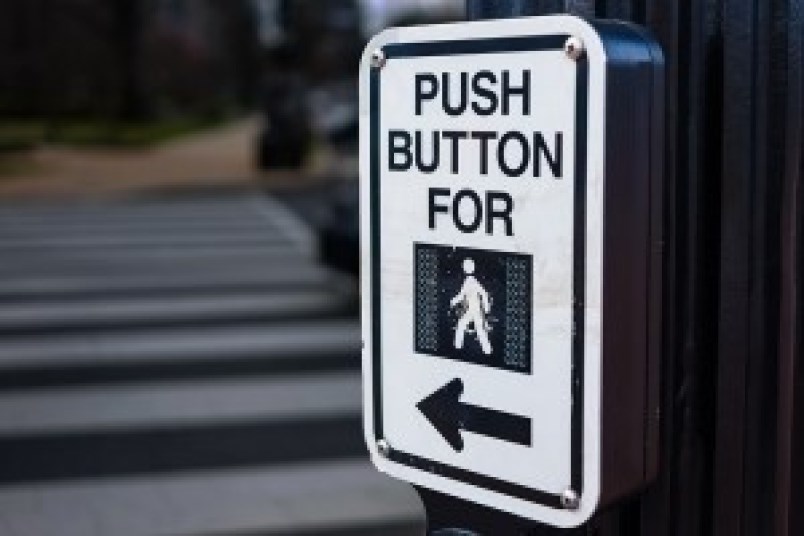A new city policy signals a desire to maximize pedestrian safety, comfort and convenience at intersections in New Westminster.
City council recently endorsed the signalized intersection policy, which aims to ensure traffic signals are aligned with the goals and priorities in the city’s master transportation plan. A report to council said most of the policy is meant for intersections with full and pedestrian-activated signals, but elements of the policy would also apply to intersections with signalized warning systems, such as special crosswalks and rectangular rapid flashing beacons.
Coun. Patrick Johnstone said he was engaged in conversations about the policy through the city’s sustainable transportation task force and the sustainable transportation advisory committee.
“It really came from some discussions, going back probably two years now, about the simple issue of beg buttons and the idea that sometimes our intersections don’t seem to emphasize the movement of pedestrians as much as they emphasize the movement of cars,” he said. “That doesn’t necessarily coincide with the priorities that exist in our master transportation plan.”
(Beg button is a term some people use to describe the buttons pedestrians must press to activate the signal that allows them to cross the street. Critics say those buttons prioritize the needs of motorists as they require pedestrians to “beg” to cross to the other side of the street.)
The City of New Westminster’s master transportation plan includes a “hierarchy of modes” that are to be considered when making transportation decisions. Walking is the top priority, followed by cycling and transit, and then commercial vehicles and cars
Johnstone said staff considered the city’s priorities and contemplated how the city could create policy around something as simple as traffic lights.
“There wasn’t really that guiding policy that aligned what we are doing engineering-wise with the master transportation plan and the priorities in it,” he said. “I think this is a really interesting conversation to go through. It went through several iterations.”
Johnstone said topics considered during the development of the plan included the length of time it takes people to cross the street, the possibility of adjusting signal timing so people who walk slower have adequate time to get across the street, and the concept of pedestrian-lead intervals, which is when the pedestrian light turns green slightly before the green light for cars.
“I hope from this point forward we will have new and better conversations about traffic lights, and engineering staff will have the ability – when we are doing work on intersection changes – to say that we are guided by policy, and that’s why we are making these changes that are not necessarily going to work the same way that intersections always did,” he said.
What’s in the policy?
The City of New Westminster’s new signalized intersection policy consists of six fundamental guiding principles:
* Traffic signals must be designed in a way that ensures pedestrian safety and optimizes pedestrian comfort and convenience (with possible delays to other road users, including people on bicycles and buses).
* Traffic signals must not present any barriers to accessibility.
* Consideration for the comfort and convenience of people on bicycles and using other non-automobile modes is important, second only to considerations for pedestrians on foot and/or using mobility aids.
* Careful consideration must be given to ensure that bus reliability is not significantly compromised.
* Changes to existing signalized intersections should be focused on enhancing or improving current infrastructure, instead of on removing existing features.
* With limited resources, priority will be given to the intersections having the highest number of pedestrians, and the city’s most vulnerable pedestrians, such as seniors, children and people with disabilities. Priority intersections will be those: near schools and walking routes to school; near services for seniors and vulnerable populations; along greenways, multi-use paths and designated bicycle routes where there are expected high pedestrian and bicycle volumes in commercial areas; near Royal Columbian Hospital and the surrounding area, as well as other medical service providers where appropriate; and around SkyTrain stations.
Implementation plan
The signalized intersection policy outlines a variety of measures that can be used immediately at intersections, including countdown timers, non-slip paint and measures to slow motorists (such as signage, pavement markings). Other measures that could be done immediately include operational improvements, such as providing longer/sufficient pedestrian crossing times, crossing times that are consistent with best practices, walk symbol on both sides of intersection with single push button where possible, leading pedestrian/bicycle intervals.
Short-term improvements are deemed to be those that can be implemented with some analysis, minor design work, construction and/or devices. They include: good and more efficient lighting; accessibility features; pedestrian-friendly signals (such as no right turn on a red light); and newer pedestrian or bicycle-related equipment (no-touch pedestrian buttons, detection cameras for earlier or more efficient walk phase activation, detection indicator lights).
The policy also outlines intersection improvements that could be pursued as “opportunity arises,” such as those done as part of other capital projects. These initiatives would include: larger scale bus priority measures and infrastructure, such as bus lanes; provision of more or better lighting as part of larger street or roadwork infrastructure projects; and shorter pedestrian crossing distances through projects such as curb extensions and road narrowing.
Follow Theresa McManus on Twitter @TheresaMcManus
Email [email protected]



